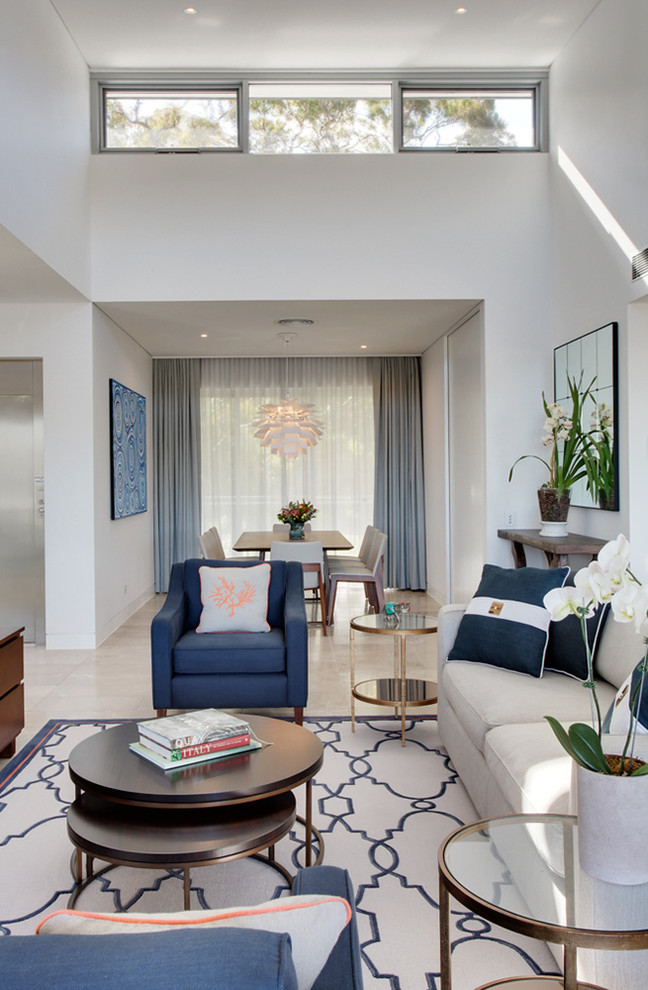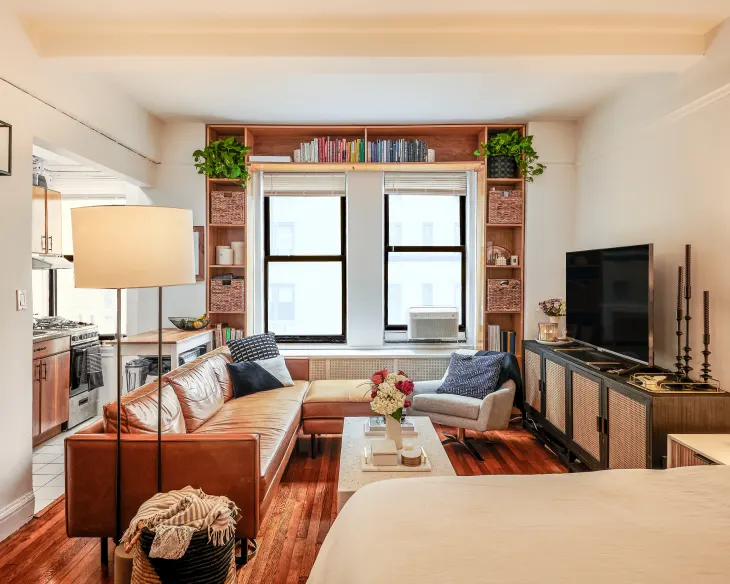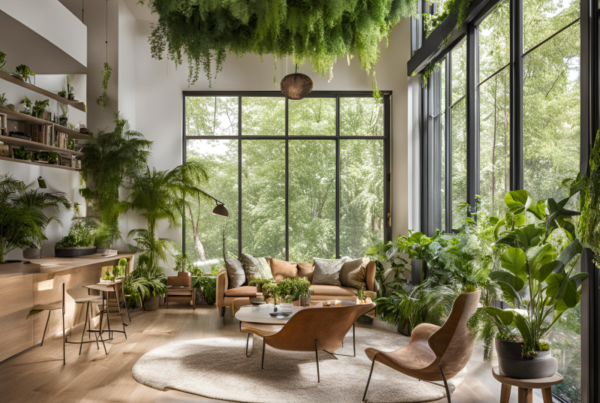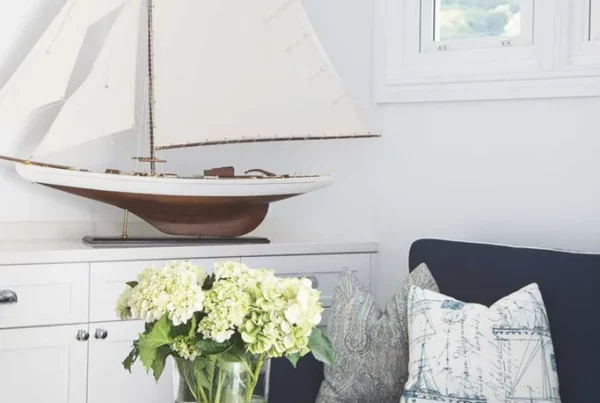In modern living, especially in urban environments, maximizing limited space is crucial for creating functional and comfortable homes. This article addresses common challenges faced by those living in compact areas by providing practical solutions for enhancing space utilization through innovative furniture design, color integration, and natural light optimization.
By exploring multi-functional furniture, strategic color placement, and effective use of natural light, you can transform small spaces into inviting and efficient environments. Read on to discover actionable strategies that will help you make the most of your home’s potential while addressing your specific needs.
Table of Contents
Maximizing Vertical Space for Style and Functionality
In today’s world, where living spaces are often limited, the challenge of maximizing vertical space has never been more crucial. By utilizing the full height of your space, you can not only create a more functional environment but also add a unique flair to your interior design. Here’s how you can enhance style and functionality by optimizing vertical space.
1. Strategically Placed Shelving
Shelving can transform walls into functional storage areas without taking up precious floor space. By exploring various shelving options, you can achieve both style and utility:
- Floating Shelves: These minimalist options create the illusion of space while providing room for decorative items or books. Position them above furniture, like sofas or desks, to utilize otherwise unused wall areas.
- Corner Shelves: Perfect for tight spaces, corner shelving makes great use of often-overlooked areas.
- Built-Ins: Consider built-in shelving units which can be custom-designed to fit your space perfectly, adding both storage and a polished look to your room.
2. Vertical Garden Solutions
Integrating plants into your home not only beautifies the space but can also promote well-being. Vertical gardens or wall-mounted plant holders provide a refreshing touch while utilizing vertical space effectively. Consider these benefits:
- Air Quality: Plants help purify the air, enhancing the overall atmosphere of your living area.
- Design Elements: Incorporate various plant sizes and types for an aesthetically pleasing vertical garden that serves as a focal point.
3. Dress Up Your Walls with Art
Art adds character and can dramatically influence the feel of a space. To maximize vertical space while displaying art:
- Gallery Walls: Create an eye-catching gallery wall. Arrange art pieces from floor to ceiling to draw the eye upward and create an illusion of height.
- Tapestries and Textiles: Using large tapestries or fabric art can soften a room while also creating vertical interest.
Consider rotating your art pieces periodically for a fresh aesthetic without major alterations to your space.
4. High-Back Furniture
Choosing high-back furniture, such as chairs or sofas, can enhance verticality and create a sense of height in your home. This technique works particularly well in compact areas:
- Defining Space: High-backed furniture can help define specific areas within open floor plans without the need for additional walls.
- Enhanced Cozy Feel: A high back can create a feeling of privacy, making the furniture more inviting and comfortable.
5. Vertical Storage Solutions
When choosing storage options, think tall rather than wide. Vertical storage efficiently utilizes height to reduce clutter:
- Tall Bookcases: Opt for tall, narrow bookcases to house books and display decor. This solution draws the eye upward, making the room feel larger.
- Over-the-Door Organizers: These clever solutions can serve numerous purposes, from holding bathroom essentials to shoes, thereby keeping items easily accessible yet out of sight.
6. Utilize Hooks and Racks
Hanging elements like hooks and racks can serve both function and aesthetic appeal. Installing these components at varying heights can add a playful yet organized touch:
- Coat Hooks: Use decorative coat hooks at various heights for jackets, bags, and hats. This approach keeps items organized and easily reachable.
- Pot Racks: In small kitchens, a hanging pot rack can save cabinet space while introducing a professional kitchen vibe.
Maximizing vertical space allows you to create a stylish and functional environment that reflects your personal taste. By integrating elements like shelving, vertical gardens, and high-back furniture, you can enhance both the aesthetic appeal and practicality of your home. To delve deeper into innovative home solutions, consider checking out resources like Apartment Therapy.
Creating Multi-Functional Furniture Solutions
As urban living spaces continue to shrink, the demand for multi-functional furniture solutions has surged. These ingenious pieces not only maximize available space but also offer flexibility and style. This article delves into innovative designs and practical tips for integrating multi-functional furniture into your home, ensuring every inch serves a purpose.
The Importance of Multi-Functional Furniture
In a world where minimalism is gaining popularity, the need for furniture that adapts to various needs cannot be overstated. Multi-functional furniture solutions maximize utility while minimising clutter. Here are some key benefits:
- Space Optimization: Pieces like murphy beds or expandable tables can transform a small room for different functions.
- Cost-Efficiency: Investing in a single item that serves multiple purposes can save money in the long run.
- Stylish Versatility: Many modern multi-functional designs incorporate aesthetic appeal, allowing you to maintain style while being practical.
Innovative Multi-Functional Furniture Ideas
With creativity at the helm, furniture designers are crafting innovative solutions tailored for compact living. Here are several standout examples:
- Convertible Sofas: Sleek contemporary sofas can easily transform into beds for guests, blending comfort and functionality.
- Coffee Tables with Storage: Some coffee tables come with built-in shelves or drawers, providing a place to store books, magazines, or blankets, keeping items tidy.
- Ottomans with Hidden Storage: These versatile pieces can be used as footrests, additional seating, or as storage solutions for items like remotes and toys.
- Dining Tables with Drop Leaves: Perfect for small dining areas, these tables can be extended when guests are over and collapsed afterward to save space.
Designing with Multi-Functional Furniture in Mind
When choosing multi-functional pieces, consider the following design tips to ensure that these items blend seamlessly into your living space:
- Prioritize Quality: Look for durable materials that withstand frequent use. This ensures longevity and better investment value.
- Measure Your Space: Be sure to accurately measure the area intended for the furniture. Opt for solutions that fit well without overwhelming the available space.
- Choose Neutral Colors: To facilitate the integration of multiple functions, select colors that complement existing decor. This allows versatility in styling.
- Evaluate Your Lifestyle: Pick pieces that meet your specific needs, such as a desk that can transform into a dining area or shelves that double as a room divider.
Incorporating Technology into Multi-Functional Designs
As technology continues to advance, integrating tech features into furniture solutions can further enhance functionality. Consider:
- Integrated Charging Stations: Look for desks or nightstands with built-in charging ports to eliminate cord clutter.
- Smart Furniture: New designs incorporate smart features like adjustable height desks and beds that react to user preferences.
Conclusion: The Future of Living Spaces
With the continuous evolution of urban environments, embracing multi-functional furniture solutions is not just a trend but also a necessity for practical living. By carefully selecting innovative pieces, you can create a functional yet stylish environment that meets the challenges of modern living.
For further insights into innovative furniture designs, explore IKEA’s website where they provide a range of products that exemplify multi-functionality in furniture.
Incorporating Bold Colors and Patterns
In today’s design landscape, incorporating bold colors and patterns into small spaces can significantly enhance the aesthetics and create an inviting atmosphere. While many may shy away from vibrant hues and striking designs for fear of overwhelming a compact area, the right approach can transform your space into a dynamic haven. Here, we’ll explore how to effectively use bold colors and patterns to inject personality into your interiors.
The Psychology of Color
Understanding the psychology of color plays a pivotal role in selecting hues for your decor. Different colors evoke various emotions and perceptions:
- Red: Stimulating and energizing, red can add warmth and excitement to a space.
- Blue: Often associated with calmness, blue can create a serene atmosphere.
- Yellow: Bright and cheerful, yellow can make a space feel sunny and welcoming.
- Green: Symbolizing nature, green can instill a sense of tranquility.
When choosing colors, consider the mood you wish to foster in your home; for instance, a vibrant red accent wall in a small living room can add drama and coziness, while soft blues can enhance the sense of openness.
Choosing the Right Patterns
Patterns can serve as a visual focal point and can also enhance the feeling of space when used wisely. Here are some tips for incorporating patterns effectively:
- Scale Matters: Opt for larger patterns to make a bold statement without cluttering the space. Conversely, smaller patterns can be used for accent pieces.
- Balance with Solids: Pair bold patterns with solid colors to avoid overwhelming the eye. This balance creates a harmonious look.
- Accent Pieces: Use patterns in throw pillows, rugs, or artwork as a way to introduce design elements without committing to permanent changes.
- Layering Patterns: When mixing patterns, ensure they share a common color palette to maintain coherence.
Strategic Color Placement
Where you place bold colors can greatly influence how they impact the room. Consider these strategies:
- Accent Walls: A single wall painted in a bold color can create an eye-catching focal point without overpowering the space.
- Furniture Choices: Choose furniture in vibrant hues, such as a teal sofa or mustard yellow chairs, to add character to your space.
- Accessorize: Incorporate bold colors through accessories like vases or art pieces that can easily be swapped out as trends evolve.
Lighting and Color Interaction
The interaction between lighting and colors is crucial in achieving the desired effects. Natural light can elevate colors, making them appear more vibrant, while artificial lighting can cast different tones. To optimize your color choices:
- Use Natural Light: Position mirrors strategically to bounce natural light around, enhancing the brightness of bold colors.
- Experiment with Light Fixtures: Choose warm or cool bulbs according to the mood you want to create. For example, warmer bulbs can soften bold colors and make the space feel cozy.
Conclusion
Incorporating bold colors and patterns into small spaces opens up a realm of creativity and design possibilities. By understanding the psychology of color, choosing the right patterns, and placing colors strategically, you can elevate your interiors without compromising functionality. For more inspiration on color theory and design techniques, check out this Houzz article on color theory.
Enhancing Natural Light in Compact Areas
Natural light is a coveted element in compact spaces, offering not just illumination but also a sense of openness and warmth. In small apartments and smaller homes, maximizing the flow of natural light can significantly enhance the ambiance, making areas feel more spacious and inviting. Below are some actionable strategies that can help you effectively illuminate your space using natural light.
1. Choose Light-Colored Walls and Decor
Opting for light-colored walls can drastically alter the perception of your compact area. Light shades such as whites, creams, and soft pastels reflect light rather than absorb it, allowing the available natural light to bounce around the room. Coupling these colors with similarly toned furnishings can help maintain a cohesive, airy feel throughout the area.
2. Use Mirrors to Reflect Light
Incorporating mirrors in your design can greatly enhance the natural light filtering into your compact space. Strategically placing mirrors across from windows can amplify sunlight across the room. Consider using oversized mirrors as statement pieces or smaller mirrors in clustered arrangements to create visual intrigue while deflecting light. A great guide on decorative mirror placement can be found at Houzz.
3. Optimize Window Treatments
The right window treatments can significantly impact the amount of natural light that enters your home. Here are several options to consider:
- Sheer Curtains: Light, sheer fabrics allow sunlight to filter through while still offering some degree of privacy. They are perfect for living rooms or bedrooms where you want warmth without sacrificing light.
- Blinds: Opt for adjustable blinds that can be tilted to control the amount of light entering but remain open to let in as much as possible.
- Skip Treatments Entirely: In particularly compact spaces, consider leaving windows bare or using minimalist treatments to maximize sunlight.
4. Create an Open Layout
An open layout that encourages air and light flow can transform small areas. Consider merging spaces wherever possible, such as combining the living room with the dining area. This configuration not only allows for more light to penetrate but also creates a more spacious feel. Use furniture to delineate areas instead of walls, maintaining a continuous sight line through the space.
5. Incorporate Glass Elements
Adding glass features such as sliding doors or glass partitions can allow natural light to travel between rooms without compromising openness. For narrower hallways, consider glass-topped tables or shelves to minimize visual obstruction while still facilitating light flow.
6. Utilize Skylights and Solar Tubes
If feasible, installing a skylight or using solar tubes can dramatically increase the amount of natural light. These options are particularly useful in areas of your home that might not have access to windows, such as kitchens or bathrooms, allowing light to filter in from above.
7. Bring the Outdoors In
Incorporating plants or outdoor elements into decor not only enhances aesthetic appeal but also creates a vibrant environment that reflects natural light. Plants, in particular, can improve air quality and add a refreshing touch to any compact area. Consider choosing plants that thrive in indirect sunlight, such as snake plants or pothos, to make the most of your light setup.
By implementing these strategies to enhance natural light in compact areas, you can create a brighter, more inviting atmosphere that feels spacious and comfortable. The result will be an environment that is both functional and beautifully illuminated, inviting you to enjoy every moment spent within those walls. To maximize vertical space in your home, consider integrating stylish shelving solutions like floating shelves, corner shelves, and built-ins. Additionally, utilize vertical storage options such as tall bookcases and over-the-door organizers to reduce clutter. Incorporating high-back furniture can create a sense of height and define spaces in open layouts, while hooks and racks can add both organization and visual interest.
Enhancing natural light is essential in compact spaces. Opt for light-colored walls and decor to reflect light, and strategically place mirrors to amplify sunlight. Use sheer curtains or minimalist window treatments to maximize light flow, and consider an open layout to encourage air and light circulation. Lastly, adding glass elements, skylights, or incorporating plants can further improve brightness and create an inviting atmosphere.





